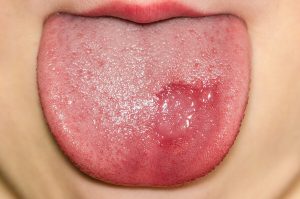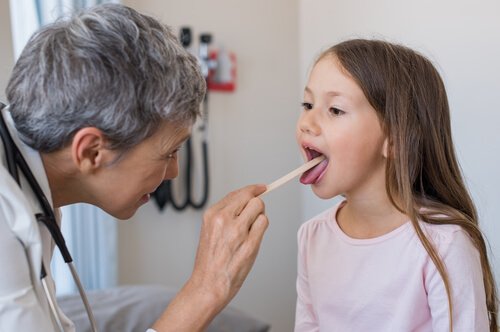Geographic Tongue in Children: Symptoms and Treatment

Geographic tongue in children usually occurs without pain. However, sometimes it can make kids feel uncomfortable and irritated. Therefore, it’s important that you know how to help your child cope with this condition.
What is geographic tongue?
It’s an inflammatory tongue condition that produces spots in the form of a map. They’re usually red and white on the edges.
Its official name is benign migratory glossitis. This name comes from the fact that the spots move around the tongue.
Generally, these spots appear on the tip, the back, and the sides of the tongue. In some cases, they reach the ventral segment.
Although it’s persistent, it’s not a dangerous condition. It doesn’t present risks to kids’ health.
Symptoms of geographic tongue in children
Often, it appears bright and smooth, and it grows rapidly. Although it’s painless, sometimes it causes discomfort. It can also create a burning sensation, especially if they eat spicy or acidic foods.
Geographic tongue also makes children loose taste buds, but only on top. Therefore, it doesn’t affect taste. In addition, new taste buds grow quickly and constantly.
The time kids may have this condition varies. It can take between a week to a month, or sometimes even longer.

It’s a constantly changing condition, and its appearance changes every day. It can even change in a matter of hours. In addition, it’s chronic, which means it will come back again.
However, if you notice that your children’s tongue is swollen, can’t breathe, speak, swallow or chew, it could be related to a serious illness. Therefore, you should go to your doctor immediately.
Causes of geographic tongue
Although we don’t know what causes it, many doctors say it’s from a lack of vitamin B.
In addition, doctors have associated it with emotional factors like stress and anxiety. Also, irritants like acids, spicy foods, hot food and tobacco could cause it.
On the other hand, there’s also a connection between geographic tongue and diseases like rhinitis and asthma.
“Although it’s persistent, it’s not a dangerous condition. It doesn’t present risks to kids’ health.”
Can you treat geographic tongue?
The causes are unknown, therefore there is no specific treatment for geographic tongue. Basically, doctors recommend avoiding things that may cause more irritation and discomfort.
In addition, they suggest taking care of your oral health by brushing your teeth with a soft bristle brush. You can also use sterile gauze to clean your children’s mouths.
On the other hand, older children should use mouthwash that contain chlorhexidine. If the discomfort persists, apply antihistamine gel where it hurts. This helps regenerate taste buds more quickly.
Another tip is to watch the food that your children eat. Some foods make it easier to get geographic tongue. For example, kiwi, banana, melon, walnuts, vinegar, and tomatoes.

What you should know about geographic tongue
You should know that this isn’t a disease, but rather a harmless condition. Although it can last a while in children, it doesn’t generally cause pain.
It might just be uncomfortable for a little while. It doesn’t require rigorous or expensive treatments, nor lots of tests.
Keep in mind that it’s not common in babies. However, there have been some cases in 6-month-old babies. However, it’s more frequent in children.
Even less young and middle-aged adults have this problem. Also, it’s more common in females than males.
In conclusion, it’s a good idea to follow these tips to prevent your children from getting geographic tongue. Of course, if you’re concerned, ask your doctor. It’s always better to be safe than sorry.
Geographic tongue in children usually occurs without pain. However, sometimes it can make kids feel uncomfortable and irritated. Therefore, it’s important that you know how to help your child cope with this condition.
What is geographic tongue?
It’s an inflammatory tongue condition that produces spots in the form of a map. They’re usually red and white on the edges.
Its official name is benign migratory glossitis. This name comes from the fact that the spots move around the tongue.
Generally, these spots appear on the tip, the back, and the sides of the tongue. In some cases, they reach the ventral segment.
Although it’s persistent, it’s not a dangerous condition. It doesn’t present risks to kids’ health.
Symptoms of geographic tongue in children
Often, it appears bright and smooth, and it grows rapidly. Although it’s painless, sometimes it causes discomfort. It can also create a burning sensation, especially if they eat spicy or acidic foods.
Geographic tongue also makes children loose taste buds, but only on top. Therefore, it doesn’t affect taste. In addition, new taste buds grow quickly and constantly.
The time kids may have this condition varies. It can take between a week to a month, or sometimes even longer.

It’s a constantly changing condition, and its appearance changes every day. It can even change in a matter of hours. In addition, it’s chronic, which means it will come back again.
However, if you notice that your children’s tongue is swollen, can’t breathe, speak, swallow or chew, it could be related to a serious illness. Therefore, you should go to your doctor immediately.
Causes of geographic tongue
Although we don’t know what causes it, many doctors say it’s from a lack of vitamin B.
In addition, doctors have associated it with emotional factors like stress and anxiety. Also, irritants like acids, spicy foods, hot food and tobacco could cause it.
On the other hand, there’s also a connection between geographic tongue and diseases like rhinitis and asthma.
“Although it’s persistent, it’s not a dangerous condition. It doesn’t present risks to kids’ health.”
Can you treat geographic tongue?
The causes are unknown, therefore there is no specific treatment for geographic tongue. Basically, doctors recommend avoiding things that may cause more irritation and discomfort.
In addition, they suggest taking care of your oral health by brushing your teeth with a soft bristle brush. You can also use sterile gauze to clean your children’s mouths.
On the other hand, older children should use mouthwash that contain chlorhexidine. If the discomfort persists, apply antihistamine gel where it hurts. This helps regenerate taste buds more quickly.
Another tip is to watch the food that your children eat. Some foods make it easier to get geographic tongue. For example, kiwi, banana, melon, walnuts, vinegar, and tomatoes.

What you should know about geographic tongue
You should know that this isn’t a disease, but rather a harmless condition. Although it can last a while in children, it doesn’t generally cause pain.
It might just be uncomfortable for a little while. It doesn’t require rigorous or expensive treatments, nor lots of tests.
Keep in mind that it’s not common in babies. However, there have been some cases in 6-month-old babies. However, it’s more frequent in children.
Even less young and middle-aged adults have this problem. Also, it’s more common in females than males.
In conclusion, it’s a good idea to follow these tips to prevent your children from getting geographic tongue. Of course, if you’re concerned, ask your doctor. It’s always better to be safe than sorry.
All cited sources were thoroughly reviewed by our team to ensure their quality, reliability, currency, and validity. The bibliography of this article was considered reliable and of academic or scientific accuracy.
- Vidal MAM, Jiménez MMC, Luna RLM. Prevalence of tongue alterations and related factors in children attending the University of Cartagena, Colombia. Rev Odont Mex. 2013;17(4):235-239.
- Jainkittivong A, Langlais RP. Geographic tongue: clinical characteristics of 188 cases. J Contemp Dent Pract. 2005 Feb 15;6(1):123-35. PMID: 15719084.
- Picciani B, Santos VC, Teixeira-Souza T, Izahias LM, Curty Á, Avelleira JC, Azulay D, Pinto J, Carneiro S, Dias E. Investigation of the clinical features of geographic tongue: unveiling its relationship with oral psoriasis. Int J Dermatol. 2017 Apr;56(4):421-427. doi: 10.1111/ijd.13460. Epub 2017 Feb 10. PMID: 28188609.
This text is provided for informational purposes only and does not replace consultation with a professional. If in doubt, consult your specialist.








